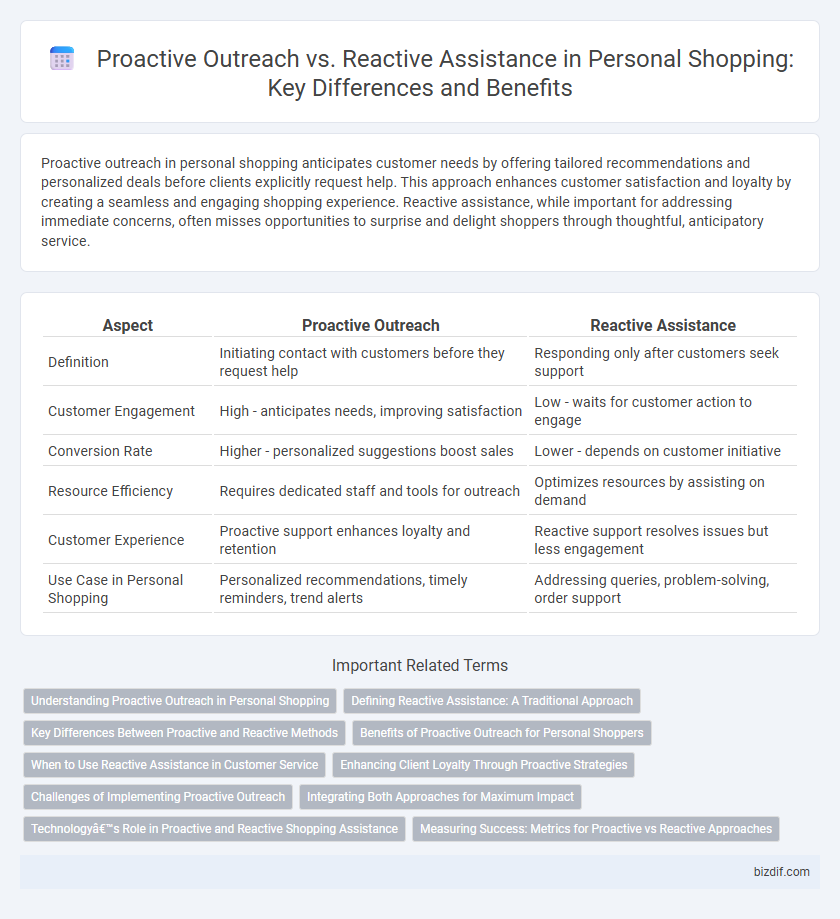Proactive outreach in personal shopping anticipates customer needs by offering tailored recommendations and personalized deals before clients explicitly request help. This approach enhances customer satisfaction and loyalty by creating a seamless and engaging shopping experience. Reactive assistance, while important for addressing immediate concerns, often misses opportunities to surprise and delight shoppers through thoughtful, anticipatory service.
Table of Comparison
| Aspect | Proactive Outreach | Reactive Assistance |
|---|---|---|
| Definition | Initiating contact with customers before they request help | Responding only after customers seek support |
| Customer Engagement | High - anticipates needs, improving satisfaction | Low - waits for customer action to engage |
| Conversion Rate | Higher - personalized suggestions boost sales | Lower - depends on customer initiative |
| Resource Efficiency | Requires dedicated staff and tools for outreach | Optimizes resources by assisting on demand |
| Customer Experience | Proactive support enhances loyalty and retention | Reactive support resolves issues but less engagement |
| Use Case in Personal Shopping | Personalized recommendations, timely reminders, trend alerts | Addressing queries, problem-solving, order support |
Understanding Proactive Outreach in Personal Shopping
Proactive outreach in personal shopping involves anticipating client needs through personalized recommendations and regular communication, enhancing customer satisfaction and loyalty. Utilizing data-driven insights and behavioral patterns allows personal shoppers to deliver tailored experiences before the customer requests assistance. This approach increases engagement and sales conversion by creating a seamless, anticipatory shopping journey.
Defining Reactive Assistance: A Traditional Approach
Reactive assistance in personal shopping refers to responding to customer inquiries or issues only after they arise, relying on shoppers to initiate contact for support or guidance. This traditional approach often delays personalized recommendations and problem resolution, potentially reducing customer satisfaction and engagement. Retailers using reactive assistance typically depend on customer-driven interactions rather than anticipating needs or offering proactive solutions.
Key Differences Between Proactive and Reactive Methods
Proactive outreach in personal shopping involves anticipating customer needs through data analysis and personalized recommendations, enhancing engagement before the customer seeks help. Reactive assistance focuses on addressing specific customer inquiries or issues as they arise, relying on the customer's initiative to request support. Key differences lie in timing and approach: proactive methods drive customer interaction preemptively, while reactive methods offer support responsively.
Benefits of Proactive Outreach for Personal Shoppers
Proactive outreach enables personal shoppers to anticipate client needs by analyzing purchasing patterns and preferences, resulting in highly personalized recommendations that boost satisfaction and loyalty. This approach increases engagement by initiating contact with curated offers before customers even express interest, driving higher conversion rates and sales. By proactively addressing potential issues or new trends, personal shoppers enhance the overall customer experience and streamline decision-making.
When to Use Reactive Assistance in Customer Service
Reactive assistance is essential when customers initiate contact with specific concerns or questions, ensuring timely and relevant support. It is most effective during post-purchase stages, handling issues like returns, product inquiries, or troubleshooting. Implementing reactive assistance improves customer satisfaction by addressing immediate needs and resolving problems efficiently.
Enhancing Client Loyalty Through Proactive Strategies
Proactive outreach in personal shopping drives client loyalty by anticipating needs and delivering tailored recommendations before customers request assistance. This approach uses data analytics and purchase history to engage clients with personalized offers, increasing satisfaction and repeat business. Reactive assistance, while necessary, often misses opportunities to deepen relationships compared to the strategic foresight of proactive engagement.
Challenges of Implementing Proactive Outreach
Implementing proactive outreach in personal shopping faces challenges such as accurately predicting customer preferences and behaviors using data analytics. Ensuring timely, personalized communication without overwhelming customers requires sophisticated AI algorithms and real-time data integration. Balancing privacy concerns with effective engagement strategies also complicates the execution of proactive outreach initiatives.
Integrating Both Approaches for Maximum Impact
Integrating proactive outreach and reactive assistance in personal shopping enhances customer engagement and satisfaction by anticipating needs and swiftly addressing inquiries. Leveraging data analytics for proactive recommendations combined with real-time support ensures personalized and seamless shopping experiences. This dual strategy maximizes conversion rates and builds long-term customer loyalty through tailored interactions.
Technology’s Role in Proactive and Reactive Shopping Assistance
Technology enhances proactive outreach in personal shopping through AI-driven data analysis that anticipates customer needs, enabling personalized recommendations before a purchase is considered. Reactive assistance leverages chatbots and real-time customer support platforms to resolve issues promptly and guide decision-making during the shopping process. Integration of these technologies increases customer satisfaction by delivering seamless, tailored experiences that adapt to individual buying behaviors.
Measuring Success: Metrics for Proactive vs Reactive Approaches
Measuring success in personal shopping requires comparing key metrics such as customer engagement rates, conversion rates, and average order value for both proactive outreach and reactive assistance. Proactive outreach often yields higher engagement and conversion due to personalized recommendations and timely follow-ups, while reactive assistance excels in customer satisfaction and issue resolution speed. Tracking customer lifetime value and repeat purchase frequency further highlights the long-term impact of proactive strategies versus reactive responses.
Proactive outreach vs Reactive assistance Infographic

 bizdif.com
bizdif.com